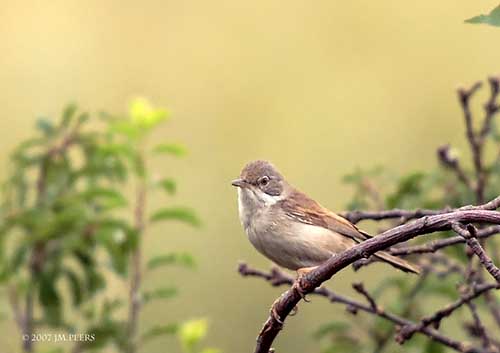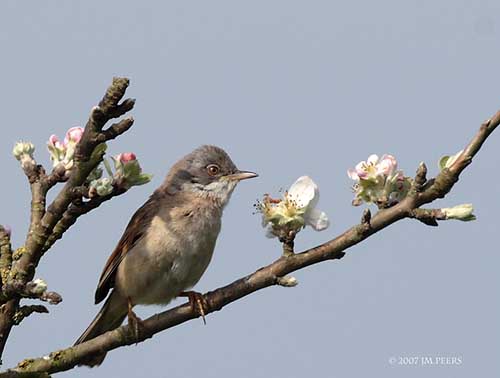
Fr: Fauvette grisette
Ang: Common Whitethroat
All: Dorngrasmücke
Esp: Curruca Zarcera
Ita: Sterpazzola
Nd: Grasmus
Sd: Törnsångare
Photographers:
José Luis Beamonte
Pájaros de España
Didier Buysse
Vision d’Oiseaux
Steve Garvie
RAINBIRDER Photo galleries & Flickr Rainbirder
Jean Michel Peers de Nieuwburgh
JMPN PHOTOGRAPHIE
Ingo Waschkies
Bird Photography
Nicole Bouglouan
PHOTOGRAPHIC RAMBLE
Text by Nicole Bouglouan
Sources :
HANDBOOK OF THE BIRDS OF THE WORLD Vol 11 by Josep del Hoyo, Andrew Elliott and David Christie - Lynx Edicions - ISBN: 849655306X
ENCYCLOPEDIE DES OISEAUX DE FRANCE ET D’EUROPE – de Peter Hayman et Rob Hume - Flammarion – ISBN : 2082009920
THE HANDBOOK OF BIRD IDENTIFICATION FOR EUROPE AND THE WESTERN PALEARCTIC by Mark Beaman, Steve Madge - C. Helm - ISBN: 0713639601
THE COMPLETE BOOK OF BRITISH BIRDS – Written by “Royal Society for the Protection of Birds” experts - Préface de Magnus Magnusson - Michael Cady- Rob Hume Editors - ISBN: 0749509112
BIRDS OF THE MIDDLE EAST by R.F. Porter, S. Christensen, P Schiermacker-Ansen C.Helm - ISBN: 0713670169
BirdLife International (BirdLife International)
Pájaros de España (JL Beamonte)
Wikipedia, the free encyclopaedia
WESCA Wildlife Network
Breeding Biology of the Common Whitethroat in Taleghan Area, Southern Slope of the Alborz Mountains - By Seyed Hadi Kathami
Common Whitethroat
Sylvia communis
Passeriformes Order – Sylviidae Family
INTRODUCTION:
The Common Whitethroat is an Old World warbler included in the family Sylviidae. Common and widespread throughout its wide range, this species is strongly migratory.
The loud song is often given from exposed perch or while moving inside bushes, but also during a short song-flight.
After a dramatic decline in 1969 due to the disastrous drought in the Sahel, S of the Sahara where this species is wintering, the Common Whitethroat has recovered stable numbers, but the densities do not reach the same levels as those recorded before 1969.

DESCRIPTION OF THE BIRD:
Biometrics:
Length: 14 cm
Weight: 14-17 g
The adult male of nominate race has grey head contrasting with the white chin and throat. The upperparts are brown to grey-brown while the wings are rufous. The uppertail-coverts are greyer than upperparts, and the tail is dark brown with whitish edges and tips to outermost rectrices.
On the underparts, chin and throat are white. Rest of underparts are mostly whitish with variable pinkish wash on lower throat and breast, mostly buffish on flanks.
The bill is dark grey with pale lower mandible. The eyes are pale brown, surrounded by greyish-white eyering. Legs and feet are pinkish-brown with yellowish tinge.
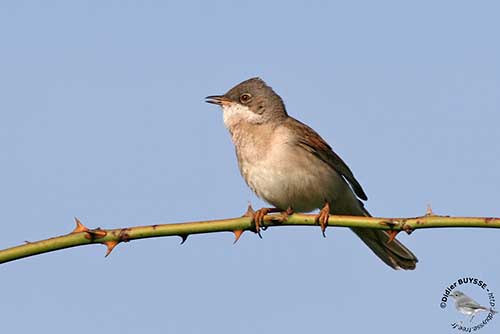
The female resembles male but she is duller and browner overall, and especially on crown and cheeks. The upperwing-coverts are duller, less rufous, and the outer rectrices show duller whitish edges. She lacks the pinkish wash on the breast. The eyes are duller too, mostly brown to olive-grey.
However, some females are similar to young males, and have grey crown and pinkish wash below.
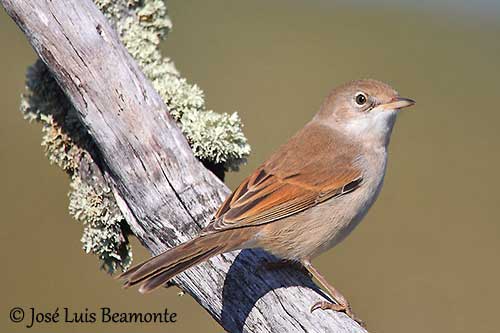
The juvenile has uniform buff-brown upperparts, white chin and throat, dull buff underparts and sandy-buff edges on outermost rectrices. The eyes are dark greyish-olive.
SUBSPECIES AND RANGE:
The Common Whitethroat has 4 subspecies.
S.c. communis (described above) breeds in Europe, E to N European Russia and Ukraine, N Turkey and NW Africa. It is a winter visitor in W and C Africa.
S.c. volgensis breeds in SE European Russia, E to SW Siberia and N Kazakhstan. The non-breeding range is unknown.
This race resembles nominate but it is slightly larger, paler and greyer above and white below.
S.c. icterops breeds in Turkey, Middle-East, Caucasus, Transcaucasia and N Iran, E to Turkmenistan. It is a winter visitor in E and C Africa.
This race is darker than nominate.
S.c. rubicola breeds in C Asian Mountains from Russian Altai, S to Uzbekistan and E to N Mongolia and S Transcaucasia. It is non-breeding visitor in E and S Africa.
This race is similar to “icterops” but with more grey above and paler overall. Underparts are whiter.
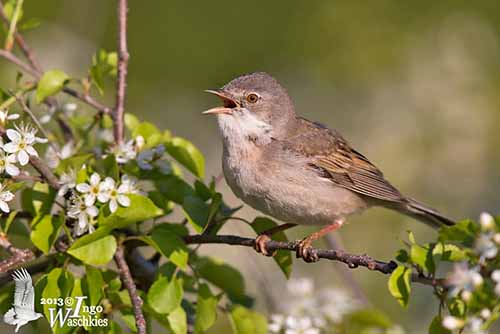
HABITAT:
The Common Whitethroat is common in a wide variety of habitats from coastal lowlands to mountains. It frequents sunny areas with bushes, shrubs and grassy patches, hedges, thickets, woodland clearings and edges, and heathland. It usually avoids densely vegetated areas and closed woodlands.
This species breeds in clearings, orchards, hedgerows on roadsides, shrubs near watercourses and pastures. It prefers the lowlands but it breeds at high elevation in some parts of the range, from 1500 up to 3200 metres for the race “rubicola”.
The non-breeding grounds consist of grassy steppes with some scattered trees, semi-arid savanna, and evergreen or semi-evergreen trees with scrub.
During migration in E Africa, it frequents dense bushes, hedges and high areas up to 2000 metres.
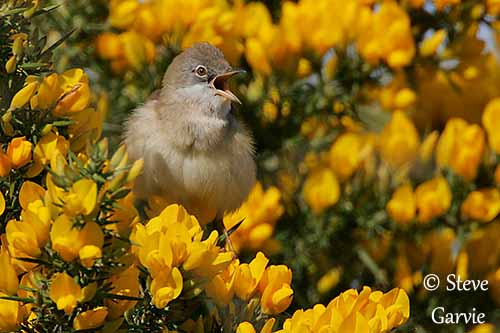
CALLS AND SONGS: SOUNDS BY XENO-CANTO
The Common Whitethroat produces a vigorous, scratchy warble. The calls include a short, harsh “churr” often continuing into a “churrrrrr-rrr-rrr” when alarmed. We can also hear a sharp, repeated “tak”, and a lively “whit-whit-whit” preceding the song and also used as contact call.
The song is a scratchy warble uttered from dense cover, open perch or in flight. The song is variable and complex, a rapid, dry, fairly musical warble “cheechiwee-cheechiweechoo-chiwichoo” with interspersed high and low notes. Some mimicry can be heard in the final phrases.
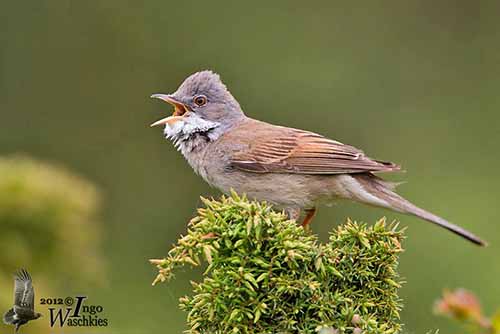
BEHAVIOUR IN THE WILD:
The Common Whitethroat feeds primarily on insects during the breeding season, especially beetles, caterpillars and bugs caught in the grass or in small bushes.
Outside the breeding season, the diet includes berries from several plant species that are the main food at this period.
It forages usually in low vegetation, gleaning preys from leaves and twigs. Insects are sometimes caught in flight.
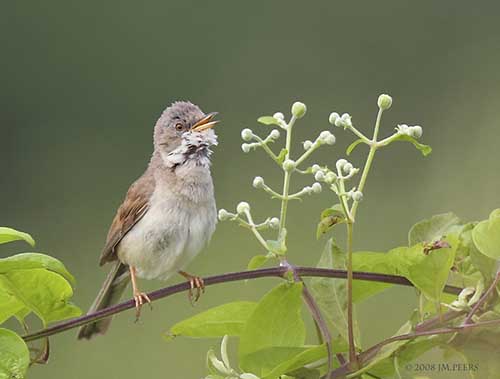
During the breeding season, the Common Whitethroat sings with the crown feathers raised into a peak, and puffed out throat feathers. It sings at top of bush or while fluttering briefly.
Males arrive some days before females at the breeding grounds, and occupy large territories. The song-flight is jerky and dancing while the male rises for up to 10 metres with spread tail. The wingbeats are butterfly-like before the bird returns to its perch or another one.
The Common Whitethroat is mostly monogamous, although some males may have two females and maintain more than one territory.
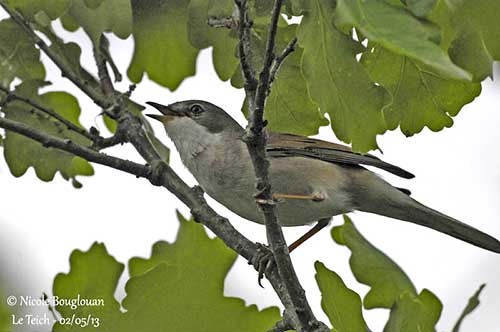
The Common Whitethroat is migratory and travels by night. All races from all populations migrate S to sub-Saharan Africa for wintering. The W populations migrate SW through Iberian Peninsula and winters mainly in W Africa. The E populations migrate through Italy and the coast of E Mediterranean Sea, and winter in C and W Africa.
This species is a long-distance migrant and it has long, pointed wings for a powerful flight. The song-flight performed during courtship is jerky and dancing.

REPRODUCTION OF THIS SPECIES:
The breeding season occurs mainly in April/July, but it often starts later in N Europe and may vary according to the elevation.
The Common Whitethroat breeds in a wide variety of habitats such as scrub with gorse, hedgerows and uplands. The male builds several nests and the female selects and completes one of these nests, or builds a new nest herself in another area.
The nest is a deep cup placed at base of bush or clump of grass. It is made with grass, leaves, rootlets, hair and spider cocoons. Usually, these birds show strong fidelity to their breeding grounds year after year.

The female lays 4-5 greenish-grey or olive eggs with dark markings. Both adults incubate during 9-14 days. The chicks are fed by both parents and fledge 10-12 days after hatching. They are independent 15-20 days after leaving the nest.
If the clutch is lost, there are 2-3 replacement clutches.
When the male has two females, the secondary clutch is often reared by the female alone, but some exceptions are reported.
PROTECTION / THREATS / STATUS:
The Common Whitethroat is common throughout its range. The European population is estimated at 14,000,000 breeding pairs and was considered stable in 1970-1990, with a small increase between 1990 and 2000.
This species is sometimes threatened on its wintering grounds by lack of rainfall and continuous drought in Sahel area of W Africa, and increasing desertification due to human pressure. In Europe, destruction of the habitat for agriculture expansion reduces the suitable breeding habitats.
However, in spite of these threats, the Common Whitethroat is currently evaluated as Least Concern.
